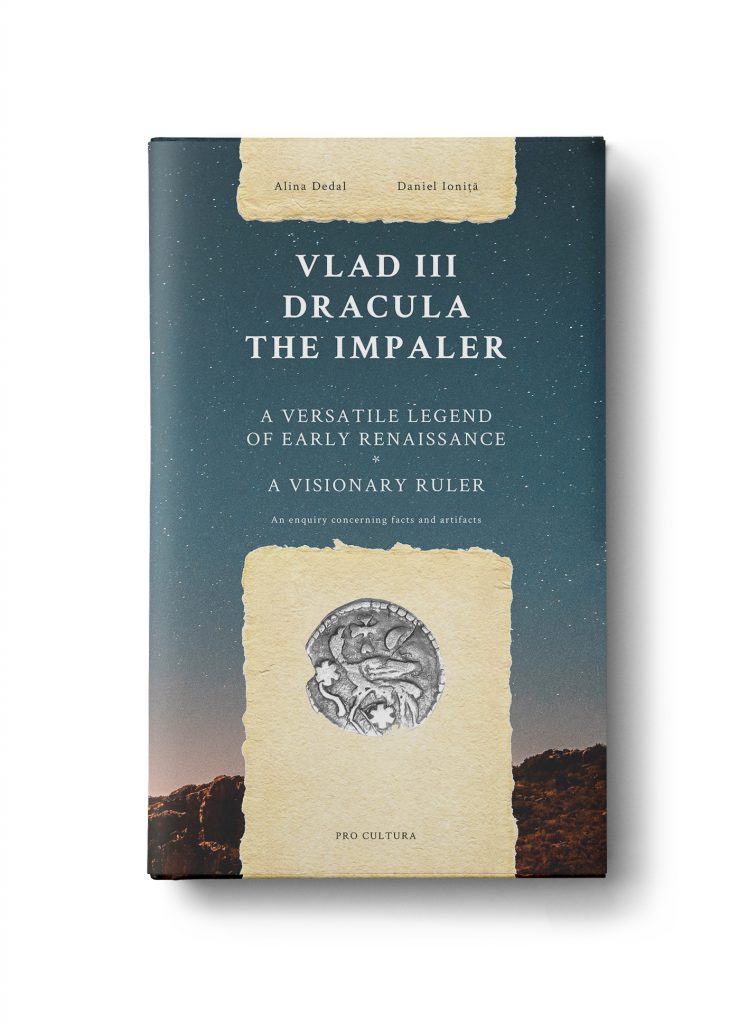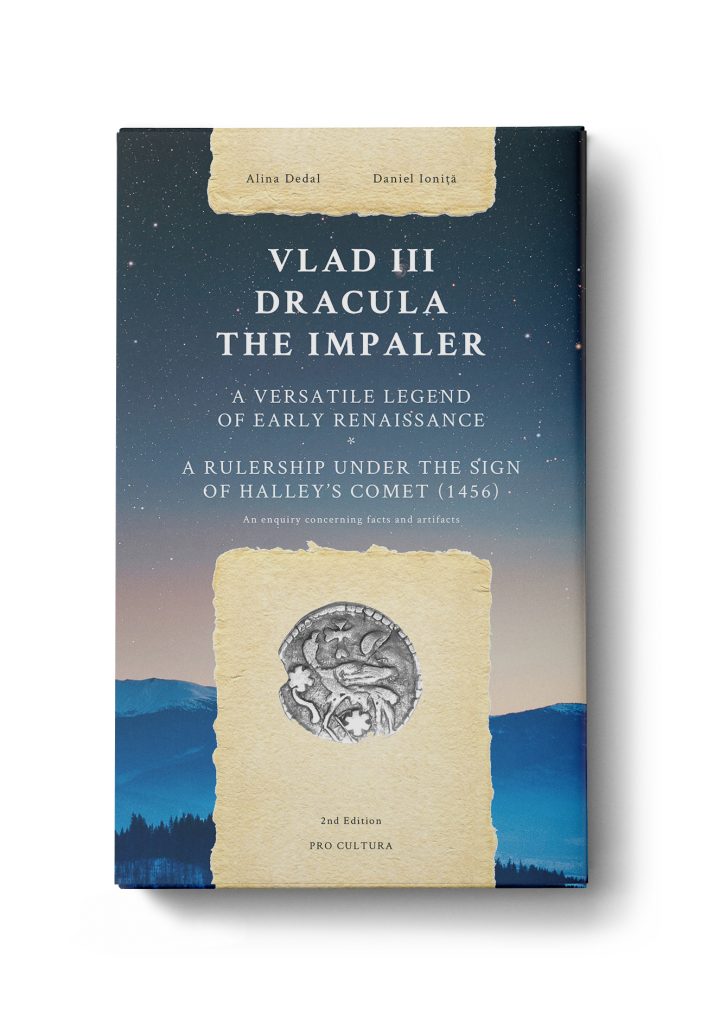

1st EDITION
VLAD III DRACULA THE IMPALER – A VERSATILE LEGEND OF EARLY RENAISSANCE – A VISIONARY RULER
An enquiry concerning facts and artifacts
ALINA DEDAL, DANIEL IONIȚĂ
Editor: Pro Cultura Publisher
București, România, 2021
ISBN 978-606-95083-4-3
Limba / Language: english
150 pagini / pages
Format / Dimensions: 14 x 23 cm
Soft cover
Tipar și legătorie / Printing and binding: Dinasty Books Proeditură și Tipografie, București
2nd EDITION
VLAD III DRACULA THE IMPALER – A VERSATILE LEGEND OF EARLY RENAISSANCE, A RULERSHIP UNDER THE SIGN OF HALLEY’S COMET (1456)
An enquiry concerning facts and artifacts
ALINA DEDAL, DANIEL IONIȚĂ
Editor: Pro Cultura Publisher
București, România, 2023
ISBN 978-606-95683-0-9
Limba / Language: english
164 pagini / pages
Format / Dimensions: 14 x 23 cm
Soft cover
Tipar și legătorie / Printing and binding: Dinasty Books Proeditură și Tipografie, București
Despre carte
Vlad III Dracula (Drăculea, Drăgulea) – principele român din secolul al XV-lea, cunoscut și sub numele de Vlad Țepeș, este unul dintre cele mai fascinante personaje ale istoriei medievale, concurând ca notorietate cu cele mai mari personalități istorice ale lumii.
Deopotrivă lăudat sau defăimat în scrierile unor cronici contemporane sau ulterioare, el a fost portretizat atât ca un tiran sângeros – imagine care a degenerat prin secole în vampirul fictiv creat de autorul irlandez Bram Stoker, la sfârșitul secolului al XIX-lea – dar și ca erou național, prototip al conducătorului creştin aspru, care a ţinut piept unui Imperiu Otoman aflat la apogeul puterii sale, un inspirat apărător nu doar al țării sale, ci și al întregii Europe.Cu cât devine mai clar conturat personajul istoric Vlad Țepeș, cu atât mai denaturată îi este imaginea, în dezbaterea contemporană actuală fiind subiectul a două perspective contrare ale aceleiași figuri mitologice: marele suveran versus tiranul absolut.
Ce l-a motivat pe Vlad III în acțiunile sale? De ce a fost descris ca un tiran teribil și un torționar, chiar în vremea sa? Cum a reușit cartea lui Stoker să transforme Transilvania într-un loc bântuit și pe Vlad într-un vampir? De ce, pentru români, Vlad Țepeș este un simbol al conducătorului absolut și drept? A transmis un mesaj peste secole, fiind, de fapt, un vizionar?
Eseul ‘Vlad III Dracula The Impaler’ caută să răspundă unor astfel de întrebări adăugând, poate, încă o piesă în marele puzzle al imaginii voievodului valah Vlad Țepeș și al rolului jucat de țara sa în contextul european al Evului Mediu. Plasându-l pe Vlad III Dracula (Țepeș) în momentul de început al Renașterii, în temporalitatea istorică a Europei occidentale, textul propune o viziune interesantă asupra vieții sale fundamentată pe analiza unor documente și prezentarea unor artefacte mai puțin cunoscute de publicul larg.
Întregul context este abordat din perspectiva cunoașterii actuale și globale a unei lumi interdependente, autorii punând cap la cap detaliile complexe și vibrante ale perioadei de început a Renașterii europene, înțeleasă ca un grup de strategii culturale într-un mediu politic extrem de turbulent.
About the book:
This new volume is in an expanded edition interwoven with a text on Vlad’s reign under the sign of Halley’s Comet (1456).
Vlad III Dracula (Drăculea, Drăgulea)– the 15th-century Romanian prince, also known as Vlad Țepeș [the Impaler], is one of the most fascinating personalities of medieval history, competing in notoriety with the greatest historical personalities of the world. And his name is so linked to that of his home country, Romania.
Ever since his lifetime, Vlad the Impaler aroused special interest among his contemporaries, an interest that has long gone beyond Central and Eastern Europe and has perpetuated into the modern age. His true story was hidden behind a veil of myths even in his day. Equally praised or vilified in the writings of contemporary or subsequent chronicles, he was portrayed both as a bloody tyrant – an image that degenerated through the centuries into the fictional vampire of the same name created by the Irish author Bram Stoker at the end of the 19th century – and as a national hero, a prototype of the harsh Christian ruler, who stood up to an Ottoman Empire at the height of its power, a defender not only of his country but of entire Europe.
As visible as he is as a historical figure so his image is distorted, being currently the subject of the contemporary debate of two opposing perspectives regarding the same mythological figure: a great sovereign or an absolute tyrant. The authors of this essay aim to answer some questions emerging from this debate, looking at the historical facts and artifacts attributed to Vlad III Dracula (Tepeş) – which are more or less known to the wider public – placing the famous protagonist in the correct historical moment of the early Renaissance and interpreting the entire context from the present time perspective of a global and interdependent world. Thus, piecing together, the complex and vibrant picture of this period of the Renaissance, we can see it more accurately as a cluster of cultural strategies within an extremely turbulent political milieu.
What motivated Vlad’s actions? Why was he depicted as a terrible tyrant and torturer, even in his own time? How did Stoker’s book manage to transform him into a vampire and Transylvania into a haunted, evil place? Why, for Romanians is he a symbol of an absolute and just ruler, perhaps even a visionary? Did he send a message through centuries for his people? How did he convey his message?
About the authors:
Alina Dedal is a freelance editor and graduate of the MA in Cultural Astronomy, University of Wales TSD (2018); Daniel Ioniță is a history graduate of the University of Bucharest, editor-documentalist, and since 2006 a European Clerk within the European Commission in Luxembourg and Brussels.
1st EDITION
LIBRĂRII PARTENERE / BOOKSHOPS
2nd EDITION
LIBRĂRII PARTENERE / BOOKSHOPS
PARTENERI MEDIA
BIBLIOTECI








